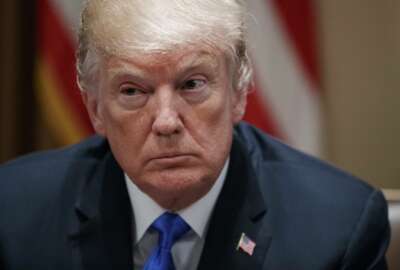
White House’s management agenda to help with ‘deep-seated transformation’ effort
The Office of Management and Budget wants agencies to establish two-year strategic goals as part of the new management agenda.
With the goal of taking on “deep-seated transformation” across the federal government, President Donald Trump is outlining six broad areas in his inaugural management agenda.
The White House says in its fiscal 2019 budget request to Congress that it will announce specific efforts in March across these six areas:
- Modernizing IT to increase productivity and security;
- Creating a 21st century framework for data that drives efficiency, accountability, and transparency;
- Developing a workforce for the 21st century;
- Improving the customer experience with federal services;
- Shifting from low-value to high-value work; and
- Improving the efficiency and effectiveness of administrative services across government.
The administration said agencies will establish concrete goals with trackable metrics. Additionally, the Office of Management and Budget and agencies will determine strategic objectives for the administration’s first term and agency priority goals for the next two years.
“The federal government must partner with Congress to fully meet modern management challenges. In some cases, real change may demand different agency structures. In other cases, the administration may require flexibility from existing requirements that impede constructive change,” the White House states in its management agenda fact sheet. “By acknowledging shortcomings, setting a modern vision, and delivering on concrete goals, the administration can adapt federal programs, capabilities and the federal workforce to meet mission demands and public expectations more efficiently, effectively and accountably.”
OMB announced today that agencies also updated their strategic plans for the next four years, and it updated the Performance.gov portal.
A major piece of this transformation is workforce reforms, including changing the way agencies reward top performers and change health and retirement benefits.
Another key piece is around technology modernization.
The White House proposes $45.7 billion for civilian agencies for technology spending, which is up about $200 million from the 2018 request.
For first time, the White House didn’t include how much the Defense Department would spend on IT as part of its overall chapter on technology.
Based on what OMB said in other parts of the budget, however, it seems DoD will spend about $45 billion as well, which would be down from the $53.1 billion request in 2018.
OMB also is decreasing the amount of money it wants for the IT Modernization Fund, asking for $220 million for 2019, down from $228 million in 2018.
So far, Congress has authorized, but not appropriated the ITMF.
“The ITMF pioneers a new model for Federal technology modernization projects,” the administration states. “The fiscal 2019 funding will complement any initial seed funding provided in fiscal 2018, when discretionary appropriations are finalized, and will help grow the revolving fund to a sustained level that will allow the ITMF to tackle more complex government-wide IT modernization efforts.”
OMB also detailed how agencies would use the new fund, starting with applying for money and a review of that application by an interagency board.
“Successful projects will operate as proofs of concept and will provide valuable insights to the board, which may recommend prioritizing the selection of more comprehensive modernization projects that can serve the interests of the Executive Branch as a whole,” the budget states.
Overall, agency IT budget requests were a mixed bag with 16 of 25 major agencies receiving some increases. OMB decided to change the way it calculated IT spending, removing about $10 billion in grants the departments of Health and Human Services and Agriculture made to state and local governments for IT systems used to administer federal benefits.

Among the agencies with the largest increases in year-over-year requests are:
- State Department—$600 million
- Commerce Department—$500 million
- Energy Department—$300 million
Several smaller agencies, including the Environmental Protection Agency ($14 million), U.S. Agency for International Development ($13 million) and the Nuclear Regulatory Commission ($10 million), saw significant increases by percentage.
To help support IT programs, OMB also requested $25 million for IT Oversight and Reform fund, mainly for cyber activities and to fund the U.S. Digital Service. This request is down from a $38 million request in 2018
The General Services Administration also requested $65 million for the Federal Citizen Services Fund, which is up from $63 million in this year’s request.
For first time, OMB detailed how much agencies spend on cybersecurity, which comes to be almost $15 billion and would be an increase of more than $500 million from last year’s request.
“Due to the sensitive nature of some activities, this amount does not represent the entire cyber budget,” the budget states. “The DoD was the largest contributor to this total. In particular, DoD reported $8.5 billion in cybersecurity funding in fiscal 2019, a $340 million (4.2 percent) increase above the fiscal 2018 estimate. At an aggregate level, civilian cybersecurity spending increased 3.9 percent in the fiscal 2019 President’s budget. Most of this change was among the civilian chief financial officer (CFO) Act agencies, for whom cybersecurity spending increased 4.1 percent from the fiscal 2018 estimate to the fiscal 2019 President’s budget.”
The Homeland Security Department would receive $1.7 billion of which $1 billion would go to supporting its efforts to safeguard the federal civilian systems against cybersecurity threats.
DHS said in a call with reporters that is it is requesting $238 million for the continuous diagnostics and mitigation (CDM) cyber program and $407 million for the EINSTEIN tools.
DoD would focus its cyber budget across three areas: safeguarding its networks, information and systems; supporting military commander objectives; and defending the nation.
“This investment would also provide the necessary resources to sustain the 133 Cyber Mission Force (CMF) teams established at Cyber Command,” the document states. “Since their inception in 2013, the CMF teams have grown in capability and capacity, and all teams are on track to be fully operational by the end of 2018.”
Copyright © 2025 Federal News Network. All rights reserved. This website is not intended for users located within the European Economic Area.
Jason Miller is executive editor of Federal News Network and directs news coverage on the people, policy and programs of the federal government.
Follow @jmillerWFED





